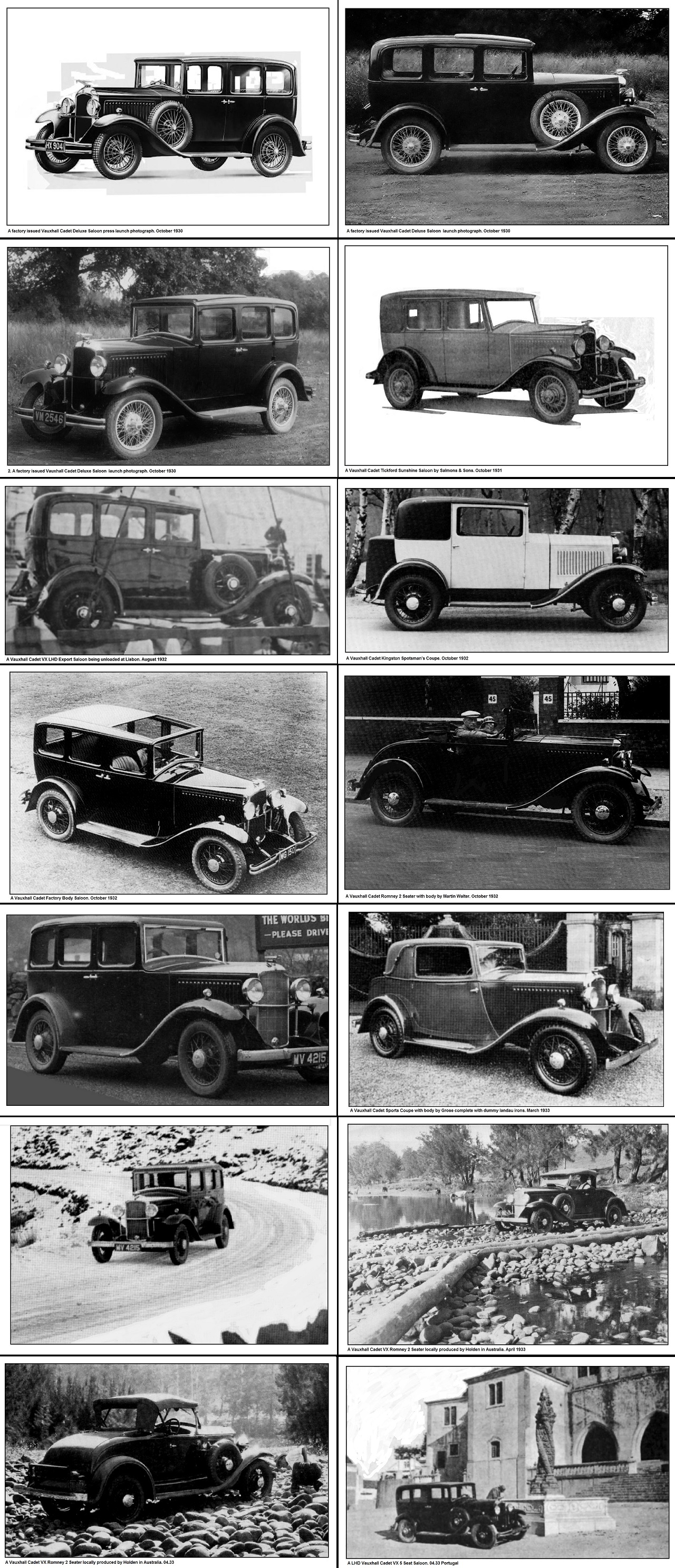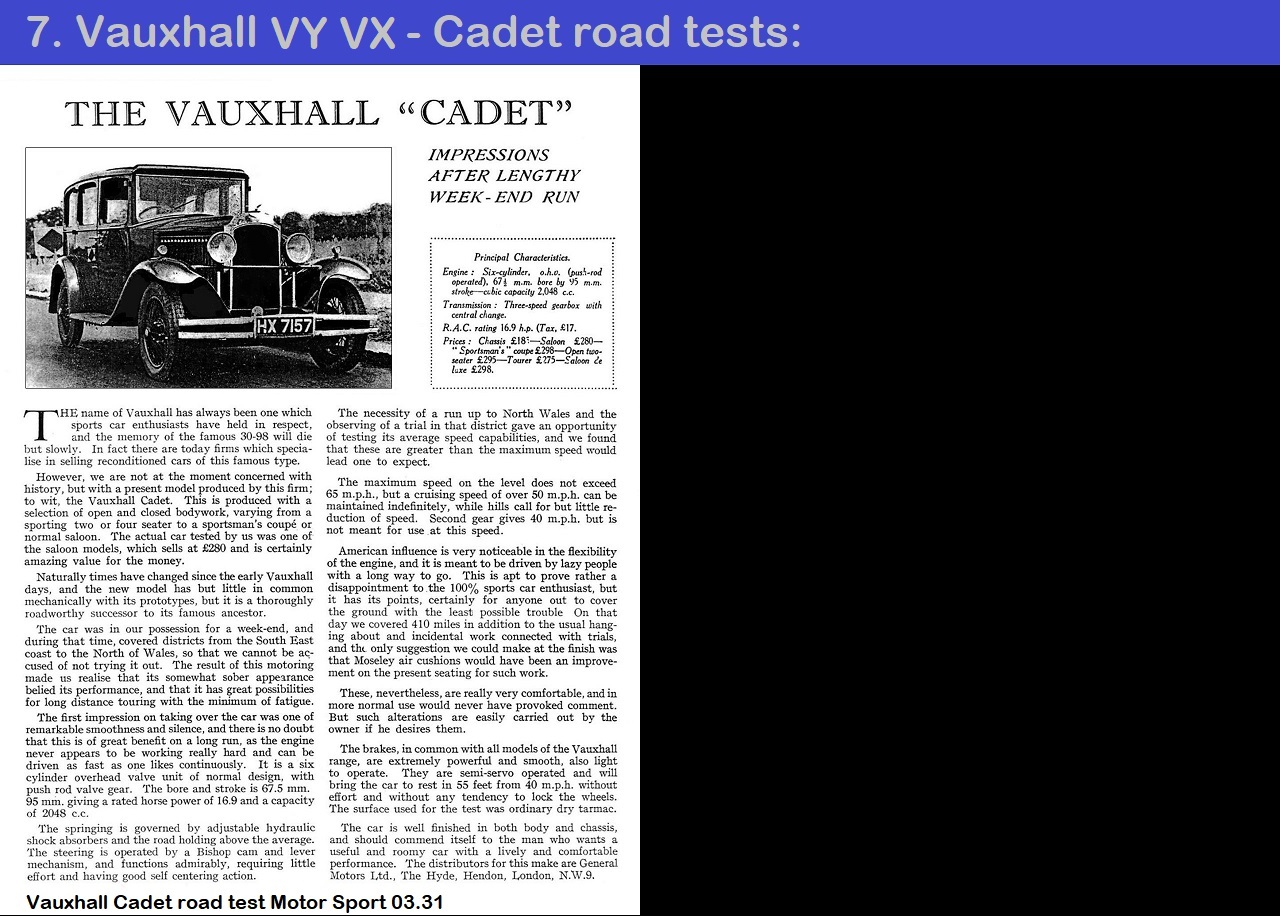
1. VAUXHALL VY VX - CADET BACKGROUND:
When Vauxhall Motors Ltd was taken over by General Motors in November 1925 most motoring analysts predicted an immediate debasing of Vauxhalls rich heritage as a quintessential British manufacturer of high quality motor cars to a down market mass producer of imported American designed vehicles. In fact, for nearly five years nothing could have been further removed from the truth. The Vauxhall 20-60 R Type, introduced in 1928, was the first new Vauxhall model introduced under General Motors ownership and was in the exact same mould as previous Vauxhall, albeit with some much-needed input to the braking system. To outsiders looking in the only visible change was the production assignment of some Chevrolet models, mainly trucks, from Hendon in London to Luton. However, behind the scenes it was a very different story; at the start of 1930 the large Vauxhall plant at Luton was producing just one model, the R Type 20-60, meaning the plant was running at about 35% of capacity which in part accounted for the fact the Vauxhall had lost money in 4 out of the first 5 years of General Motors ownership. However, since late in 1928 plans were being made to expand capacity, introduce new production methods and build a new smaller Vauxhall model with an advanced specification which would see the Company enter the sub-£300 market for the first time in many years. The car would be the new VY VX Cadet and would steer Vauxhall Motors Ltd in a new and very different direction than before.
2. VAUXHALL VY VX - CADET DESIGN &
ENGINEERING:
Planning, designing & investing in plant & equipment in preparation for the introduction of a new car in the middle of the worst economic recession the World had seen, before or since, was not perhaps most people’s idea of a sound business strategy but General Motors, one of very few companies that could afford to do it, were confident that the slump would pass and therefore Vauxhall would be ready to take full advantage of future opportunities. This was certainly true for GM in America but in Britain & Europe, in fact the rest of the World, the clouds of depression took a little longer to clear. Development of the new Vauxhall V Series started in 1928 with, as was custom & practice, the chassis and engine but this process would have a benefit that could not have been foreseen at the time. The chassis followed the same Vauxhall design principles as the earlier R Type but on a smaller scale with a pressed steel frame, 107ins wheelbase, semi-elliptic leaf springs & hydraulic shock absorbers all round and Bishop cam-and-lever steering. Some General Motors influence was evident in the use of 6volt electrics, modified Bendix cable braking and vacuum operated windscreen wipers.
Engine specification & choice was influenced by Britain’s eccentric vehicle taxation system. A new 6-cylinder 2048cc engine with a pressure lubricated crankshaft in 4 main bearings was designed for the domestic VY models, rubber mounted it produced a healthy 42bhp @ 3300rpm and had an RAC rating of 17hp. In true Vauxhall tradition, it was smooth, flexible & quiet and was combined with a 3-speed crash gearbox with a final drive ratio of 5.1:1 which gave a top speed of 60 to 65mph. Export markets, where taxation was not as archaic as in Britain, used a completely different 6-cylinder engine which was a Vauxhall modified version of the “Cast Iron Wonder” engine being fitted to Chevrolet trucks at the time. The VX engine was fitted with a 4-bearing crankshaft instead of 3 and the primitive splash lubrication was changed to a proper pressurised system. Despite being 50% larger the export engine only produced 44bhp but at a very low 2400rpm which meant a higher back axle ratio was required, if it was sold in Britain it would have incurred a huge RAC rating of 26hp. From 1931 this engine would also be used in the new Bedford truck which replaced the Chevrolet offerings, commercial vehicle taxation was calculated in a different way to private cars.
Eric Kennington, along with a very small team, oversaw what had been known within Vauxhall as the ”Body Department” and within General Motors as “Art & Colour Department”. However, despite numerous requests, Kennington refused point blank to travel to the US for any design training by Harley Earl at the Detroit studios. Fortunately, David Jones would join Vauxhall in a few years and his first assignment was to be seconded to the US instead of Kennington. In the meantime, Earl sent two of his stylists to Vauxhall to assist with the VY VX project with the aim of incorporating American practice where appropriate while Kennington was in overall charge to ensure that the new Vauxhall retained British appearance.
General Motors had taken over the operations of Adam Opel in Germany in 1929 and already possessed the designs & experience of semi-mass production techniques which could now be employed by Vauxhall in Britain for the new VY VX. In fact, according to Eric Bates, who began work in the Vauxhall Engineering Drawing Office in 1930, the smaller Vauxhall used the new Opel Kadett as a template and were using Kadett design drawings and modifying them as needed, it was also the reason for the name Cadet being chosen for the car, being the English translation of the German name.
The project brief for the Vauxhall Cadet was to offer a smooth & flexible 6-cylinder car offering excellent value for money, fully equipped, with quality engineering and excellent “British” factory built coachwork, including a leather trimmed interior, and to enter the greater volume market at a starting price under £300. Unlike previous models, the new Vauxhall Cadet would be sold without any performance or sporting pretensions.
The Vauxhall Cadet was launched on 06 October 1930 in time for the London Motor Show and was well received by the motoring press & public alike but sales were not the runaway success that General Motors had hoped for and production never exceeded 3200 units per year. This was no fault of the car and had more to do with the economic situation, the Cadet was just above what the “average” motorist could afford and therefore was just outside of the largest part of the volume market.
In October 1931 Vauxhall announced a raft of improvements to the Cadet: 12-volt electrics, replacement of the original Bishop cam-and-lever steering with a Males-Weller system, larger hubs with chrome caps, full rubber mounting for the rear axle and different bumper & headlight mountings. However, the biggest change, and a first for a British car - beating Rolls Royce by four months, was the fitment of synchromesh for 2nd & 3rd gears. It had been developed by General Motors under Ernst Seaholm who had originally been shown the system by Earl Thompson who had taken out a patent on the design in 1922. Synchromesh gears were first introduced on the 1929 Cadillac 341 models. It was a revelation for the normal motorist for whom a smooth gearchange by double de clutching was a rarity. Eventually, synchromesh gears would be copied by every other car manufacturer.
The Cadet was produced until July 1933, it was directly replaced in the Vauxhall range by new 12 & 14hp Light Six.
3. VAUXHALL VY VX - CADET PRESS & PERIOD
PHOTOGRAPHS:

4. VAUXHALL VY VX - CADET SPECIFICATIONS:




